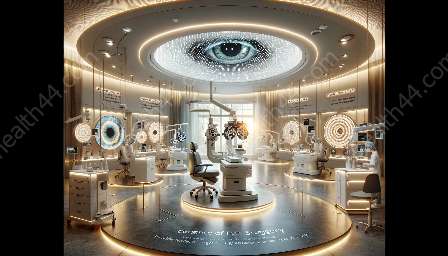Oculofacial plastic surgery is a specialized branch of medicine that focuses on the delicate structures of the eyes and surrounding areas. It encompasses a wide range of surgical techniques and treatments aimed at enhancing both the function and appearance of the eyes, eyelids, and face. This comprehensive guide explores the fascinating world of oculofacial plastic surgery and its intersection with eye surgery, surgical techniques, and vision care.
The Art and Science of Oculofacial Plastic Surgery
Oculofacial plastic surgery, also known as oculoplastic surgery, is dedicated to the reconstruction, repair, and rejuvenation of the eyelids, eye sockets, tear ducts, and surrounding facial structures. Oculofacial plastic surgeons are specially trained to address a diverse spectrum of conditions, including congenital deformities, trauma-related injuries, aging-related changes, and various functional issues that affect the eyes and their adjacent structures.
These highly skilled specialists undergo rigorous training that uniquely qualifies them to perform intricate surgeries, both cosmetic and reconstructive, in this delicate area. They possess a deep understanding of the complex anatomy and physiology of the eyes and surrounding facial structures, allowing them to deliver highly specialized care with precision and expertise.
Advanced Surgical Techniques in Oculofacial Plastic Surgery
The field of oculofacial plastic surgery incorporates an array of advanced surgical techniques to address a multitude of conditions. These techniques may include blepharoplasty (eyelid surgery) to correct drooping eyelids and improve visual function, orbital decompression to alleviate pressure on the eyes in cases of thyroid eye disease, and surgical repair of tearing disorders to ensure proper drainage of tears from the eyes.
Moreover, oculofacial plastic surgeons are proficient in performing intricate reconstructions after trauma or tumor removal, restoring both the form and function of the affected structures. Whether it involves repairing a damaged eyelid following an injury or reconstructing the eye socket after the removal of a tumor, these specialists possess the expertise to achieve optimal outcomes while prioritizing aesthetics and patient well-being.
Intersecting with Eye Surgery and Vision Care
Oculofacial plastic surgery intersects with eye surgery and vision care in multiple ways. While oculofacial plastic surgeons focus on the aesthetic and functional aspects of the eyes and surrounding structures, their work often complements the field of general ophthalmology and contributes to overall vision care.
In cases where oculofacial plastic surgery is performed to address drooping eyelids (ptosis) or eyelid malpositions that impact vision, it can significantly improve the ocular health and visual function of the affected individuals. By collaborating with ophthalmologists and optometrists, oculofacial plastic surgeons ensure that their interventions not only enhance the appearance of the eyes but also contribute to maintaining or restoring optimal vision.
Furthermore, some oculofacial plastic surgeons specialize in the treatment of orbital and eyelid tumors, working in tandem with oncologists and ophthalmic oncologists to provide comprehensive care for patients with these conditions. Their expertise in managing complex reconstructive cases also plays a crucial role in supporting individuals who require specialized eye surgery following trauma or severe facial injuries.
Advancements in Oculofacial Plastic Surgery
As with other medical specialties, oculofacial plastic surgery continues to evolve with technological advancements and innovative treatment modalities. From the incorporation of minimally invasive techniques to the utilization of advanced imaging technologies for precise preoperative planning, the field is constantly progressing to offer enhanced outcomes and patient satisfaction.
Moreover, the integration of aesthetic procedures within oculofacial plastic surgery allows patients to benefit from comprehensive care that not only addresses functional concerns but also enhances the natural beauty of the eyes and surrounding facial areas. These aesthetic treatments may include nonsurgical rejuvenation techniques, such as injectable dermal fillers and botulinum toxin injections, which can effectively rejuvenate the appearance of the eyes and diminish signs of aging.
Ensuring Comprehensive Vision Care
While oculofacial plastic surgery primarily focuses on the aesthetic and functional aspects of the eyes and surrounding structures, its ultimate goal aligns with the broader objective of ensuring comprehensive vision care for individuals. By integrating specialized surgical techniques and treatments with the principles of eye surgery and vision care, oculofacial plastic surgeons play a vital role in addressing a diverse range of conditions that impact both the appearance and function of the eyes.
Through their expertise in treating congenital abnormalities, eyelid malpositions, tear drainage disorders, and other conditions, these specialists make significant contributions to improving the quality of life and visual well-being of their patients. By embracing a holistic approach that encompasses both medical and aesthetic considerations, oculofacial plastic surgery stands at the forefront of enhancing eye health and beauty.
Conclusion
Oculofacial plastic surgery represents a captivating field that marries the art and science of surgery with a profound dedication to enhancing the visual well-being and aesthetic appeal of the eyes and adjacent structures. As it intersects with eye surgery, surgical techniques, and vision care, oculofacial plastic surgery serves as a pivotal component of comprehensive eye health and beauty. By embracing innovative advancements and integrating diverse treatment modalities, oculofacial plastic surgeons continue to offer transformative solutions that uplift the lives of their patients while safeguarding their ocular health and natural beauty.


